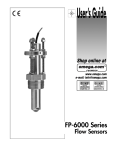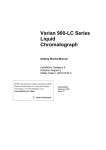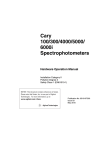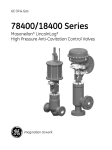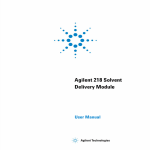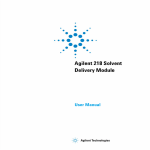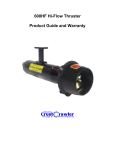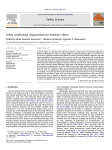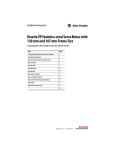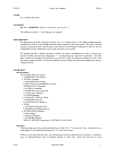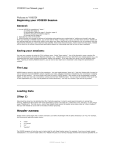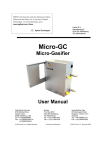Download Dynamic Mixer Manual
Transcript
Varian Dual Chamber Dynamic Mixer Instruction Manual Installation Category II Pollution Degree 2 Safety Class 1 (EN 61010-1) Publication no. 0391467400 Issue 5 February 2009 Varian Dual Chamber Dynamic Mixer Varian, Inc. – Serving Industries Worldwide Biosciences Pharmaceuticals Clinical Research and Forensics Food and Agriculture Chemical Analysis Environmental Fuels and Energy Material Sciences Sales and Service Contact Details North America: 800.926.3000, 925.939.2400 Europe, The Netherlands: 31.118.67.1000 Asia Pacific, Australia: 613.9560.7133 Latin America, Brazil: 55.11.3238.0400 Varian, Inc. Web Site www.varianinc.com Varian, Inc. is the owner of copyright on this document and any associated software. Under law, the written permission of Varian, Inc. must be obtained before the documentation or the software is copied, reproduced, translated or converted to electronic or other machine-readable form, in whole, or in part. Updated February 2009. Varian and the Varian logo are trademarks or registered trademarks of Varian, Inc. in the U.S. and other countries. © 1998-2009 Varian Inc. ii Publication no. 0391467400, Issue 5, February 2009 Varian Dual Chamber Dynamic Mixer Declaration of Conformity We hereby declare that the equipment listed below complies with the requirements of: The Low Voltage Directive 73/23/EEC (93/68/EEC) The EMC Directive 89/336/EEC (92/31/EEC and 93/68/EEC) Applicable Standards LVD BS EN 61010-1:1993 EMC BS EN 61326:2003 Equipment Model Number Varian Dual Chamber Dynamic Mixers Authorized Representative in the EU Name: G. A. Wassink Signed: Position: Quality Manager Date: 1 February 2009 Company Name Address Varian BV Herculesweg 8 4338 PL Middelburg The Netherlands Telephone Facsimile +31 (0) 118 671 000 +31 (0) 118 633 118 Manufacturer Name: Philip Binns Signed: Position: Director of Operations Date: 1 February 2009 Company Name Address Varian Australia Pty Ltd 679 Springvale Road Mulgrave VIC 3170 Australia Telephone Facsimile +61 (0) 3 9560 7133 +61 (0) 3 9560 7950 Publication number 8 510251600 Febr uary 2009 Publication no. 0391467400, Issue 5, February 2009 iii Varian Dual Chamber Dynamic Mixer This page is intentionally left blank. iv Publication no. 0391467400, Issue 5, February 2009 Varian Dual Chamber Dynamic Mixer Contents General Safety Precautions 1 CE Compliance 1 Electrical Hazards 1 Note, Caution and Warning Messages 2 Service Availability 3 1. 5 Introduction 1.1 General 5 2. 9 Installation 2.1 Unpacking 9 2.2 Plumbing 9 2.2.1 Binary Gradient HPLC Connections 9 2.2.1 Ternary Gradient HPLC Connections 10 2.3 Plumbing Fittings 2.3.1 0.6 mL and 1.2 mL Stainless Steel Mixers 12 12 2.3.2 1.2 mL PEEK, 0.6 mL Titanium and 1.2 mL Titanium Mixers 12 2.3.3 10 mL PEEK and Titanium mixers 13 2.4 Electrical Connections 13 2.5 Mounting 14 3. 17 Maintenance and Troubleshooting 3.1 Operating Precautions 17 3.2 Mixer Disassembly 17 3.3 Cleaning the Mixer Components 20 3.4 Mixer Reassembly 20 3.4.1 Analytical and Narrowbore Mixers 20 3.4.2 Preparative Mixers 20 Publication no. 0391467400, Issue 5, February 2009 v Varian Dual Chamber Dynamic Mixer 3.4.3 vi All Mixers 21 3.5 Checking and Replacing the Outlet Filter Frit 22 3.6 Seal Replacement 23 3.7 Troubleshooting 24 4. Spare Parts 25 5. Specifications 27 Publication no. 0391467400, Issue 5, February 2009 Varian Dual Chamber Dynamic Mixer General Safety Precautions Follow these safety practices to ensure safe equipment operation: • Perform periodic leak checks on all supply lines and pneumatic plumbing. • Store organic solvents in fireproof, vented and clearly labeled cabinets so they are easily identified as toxic and/or flammable materials. • Do not accumulate waste solvents. Dispose of such materials through a regulated disposal program and not through municipal sewage lines. • This instrument is designed for chromatographic analysis of appropriately prepared samples. It must be operated using appropriate gases and/or solvents and within specified maximum ranges for pressure, flows, and temperatures as described in this manual. If the equipment is used in a manner not specified by the manufacturer, the protection provided by the equipment may be impaired. • It is the responsibility of the Customer to inform Varian Customer Support Representatives, if the instrument has been used for the analysis of hazardous biological, radioactive, or toxic samples, prior to any instrument service being performed or when an instrument is being returned to the Service Center for repair. CE Compliance This product complies with the requirements of the European Union which allow the CE marking to be affixed. Electrical Hazards • Replace faulty or frayed power cords immediately with the same type and rating. • Make sure that voltage sources and line voltage match the value for power supply module. Publication no. 0391467400, Issue 5, February 2009 Page 1 of 28 Varian Dual Chamber Dynamic Mixer Note, Caution and Warning Messages This instruction manual is provided to help you establish operating conditions which will permit safe and efficient use of your equipment. Special considerations and precautions are also described in the manual, which appear in the form of Notes, Cautions and Warnings as described below. It is important that you operate your equipment in accordance with this instruction manual and any additional information which may be provided by Varian. Address any questions regarding the safe and proper use of your equipment to your local Varian office. Note Caution A note provides information to aid you in obtaining optimal performance from your instrument. A Caution message is used when failure to observe instructions could result in damage to equipment (Varian supplied and/or other associated equipment). The meanings of the symbols that may appear alongside warnings in the documentation or on the instrument itself are as follows: Chemical hazard Fire hazard The following symbol may be used on warning labels attached to the instrument. When you see this symbol, refer to the relevant operation or service manual for the correct procedure referred to by that warning label. Page 2 of 28 Publication no. 0391467400, Issue 5, February 2009 Varian Dual Chamber Dynamic Mixer Service Availability Varian provides a variety of services to support its customers after warranty expiration. Repair service can be provided by attractively priced service contracts or on a time and material basis. Technical support and training can be provided by qualified personnel on both a contractual or as-needed basis. Publication no. 0391467400, Issue 5, February 2009 Page 3 of 28 Varian Dual Chamber Dynamic Mixer This page is intentionally left blank. Page 4 of 28 Publication no. 0391467400, Issue 5, February 2009 Varian Dual Chamber Dynamic Mixer 1. 1.1 Introduction General Varian Dynamic Mixers are dual-chamber high pressure dynamic mixers designed for binary and ternary gradient HPLC and preparative HPLC systems. The unique design of the Varian Dynamic Mixer employs a motor driven magnet oriented perpendicularly to the mixing chambers. As the magnet turns, it causes two magnetic stir bars inside the chambers to rotate by radial drive rather than by axial drive as in other dynamic mixers. The close proximity of both stir bars to the rotating drive magnet and the fact that the stir bars rotate in opposite directions ensures continuous and thorough mixing. Power is provided by the 9 VAC external transformer. Exploded views of the mixers can be seen in Figure 8 and Figure 9 in the Maintenance and Troubleshooting section. A unique piston-type closure on the outlet of the mixer allows easy disassembly without tools for cleaning and maintenance. On analytical and narrowbore mixers the piston incorporates a 2 µm solvent filter to protect system components from contamination. The mixer is designed to be plumbed into an HPLC system between the pumps and the injection valve. A mounting post and a mast clamp come with the each mixer to allow it to mount to the side of various HPLC pumps or to mount to the mast of an HPLC system. Titanium and PEEK Varian Dynamic Mixers are available for biochemical applications where 316 stainless steel may be inappropriate because of corrosion or release of metal ions into solution. Titanium or PEEK plumbing components can be used together with PEEK tubing to provide a totally iron-free fluid path. Publication no. 0391467400, Issue 5, February 2009 Page 5 of 28 Varian Dual Chamber Dynamic Mixer 1 2 3 5 4 6 7 8 9 11 10 12 Figure 1. Section view of the Varian Dynamic analytical mixer body Where: 1. 10-32 fitting (extra long) 2. Piston 3. 4. 5. 6. 7. 8. Mixer cap Seal Drive magnet Seal retainer Frit Stir bar (upper) 9. Spacer 10. Shaft 11. Stir bar (lower) 12. 10-32 fitting (standard, 2 each) Page 6 of 28 Publication no. 0391467400, Issue 5, February 2009 Varian Dual Chamber Dynamic Mixer Solvents from the pumps enter the mixer via the two inlet ports at the base of the mixer body. They flow into the lower mixing chamber, where they are mixed by the rotation of the lower stir bar. The pressure from the pumps forces the mixed mobile phase upward through the spacer into the upper mixing chamber, where additional mixing is performed by the opposite rotation of the upper stir bar. The fully mixed mobile phase is then forced through a 2 µm frit (in analytical and Narrowbore mixers), through the piston, and out to the rest of the HPLC system. Since the spacer (the stir-bar cage on preparative mixers) assures isolation between the two mixing chambers, the Varian Dynamic mixer acts as a two-stage filter for solvent composition noise. It is more effective in averaging and reducing solvent composition noise than a single-chamber mixer of equivalent volume. The passive seal used in Varian Dynamic mixers is a hollow molded plastic ring with a circular groove containing an energizing spring. The side of the seal containing the spring faces into the mixer chambers. When the mixer is unpressurized, the small spring inside the seal maintains contact with the mixer bore and the piston with enough force to seal at low pressures, but not excessive force to prevent the seal from sliding as the mixer cap is hand-tightened. When pressurized, mobile phase entering the mixer body presses the seal against the mixer bore and the piston with increased force. The increased force maintains sealing action at HPLC pressures. Caution Over tightening the cap with tools may damage the cap or body. The inlet ports on the analytical and narrowbore mixers accept standard 10-32 fittings. The outlet port uses an extra-long 10-32 fitting. On the preparative-scale, both inlet and outlet ports accept 1/4-28 fittings for 1/8 in. tubing. Effective sealing in Varian Dynamic mixers is a function of the passive sealing mechanism only. The sealing action cannot be improved by tightening the cap with more force than can be applied by hand. Publication no. 0391467400, Issue 5, February 2009 Page 7 of 28 Varian Dual Chamber Dynamic Mixer This page is intentionally left blank. Page 8 of 28 Publication no. 0391467400, Issue 5, February 2009 Varian Dual Chamber Dynamic Mixer 2. 2.1 Installation Unpacking Before opening the shipping container, check for signs of damage or rough handling. Report damage to the carrier and your local Varian sales/service office. 2.2 2.2.1 Plumbing Binary Gradient HPLC Connections 1 5 7 2 4 8 6 3 Figure 2. Plumbing for a typical binary gradient HPLC Where: 1. Pressure module 2. 3. 4. 5. 6. 7. Pump A Pump B Mixer Prime/Purge valve Column Injection valve 8. Detector Publication no. 0391467400, Issue 5, February 2009 Page 9 of 28 Varian Dual Chamber Dynamic Mixer Warning – Chemical Hazard Death, serious injury, or damage to skin can result from contact with chemicals used in HPLC, especially when under high pressure. Always wear appropriate protective equipment and clothing. Caution To prevent rupture or component damage, the maximum working pressure of the HPLC system should not exceed the rated value of any component within the HPLC system. To connect the mixer to your HPLC system: 1. Connect the high-pressure outlet lines from the pumps to the mixer inlet ports. 2. Connect the mixer outlet to the prime-purge valve. For normal use, flow from the pumps is directed through the injection valve and the column. 3. Connect the outlet from the prime-purge valve to the injection valve and then to the column. 4. Connect the column outlet to SAMPLE IN on the detector, and SAMPLE OUT to waste or a fraction collector. Note 2.2.1 Connect any external pressure module into the HPLC system as shown in Figure 2. Ternary Gradient HPLC Connections Ternary gradient HPLC connections are identical to that of the binary gradient system except that the high-pressure outlet lines from pumps B and C are connected through a Tee to the mixer inlet ports. Page 10 of 28 Publication no. 0391467400, Issue 5, February 2009 Varian Dual Chamber Dynamic Mixer 1 7 9 2 5 6 8 10 3 4 11 Figure 3. Plumbing for a typical ternary gradient HPLC Where: 1. Pressure module 2. 3. 4. 5. 6. 7. Pump A Pump B Pump C Tee Mixer Prime/Purge valve 8. 9. 10. 11. Column Injection valve Detector Fraction collector Warning – Chemical Hazard Death, serious injury, or damage to skin can result from contact with chemicals used in HPLC, especially when under high pressure. Always wear appropriate protective equipment and clothing. Caution To prevent rupture or component damage, the maximum working pressure of the HPLC system should not exceed the rated value of any component within the HPLC system. Publication no. 0391467400, Issue 5, February 2009 Page 11 of 28 Varian Dual Chamber Dynamic Mixer Note 2.3 2.3.1 If your system has an external pressure monitor, plumb it between one pump and either the mixer or the tee, as shown in Figure 3. Plumbing Fittings 0.6 mL and 1.2 mL Stainless Steel Mixers For the extra-long fitting on the outlet and the two standard fittings for the inlet, slide the fitting and ferrule over the 1/16 in. OD tubing and push the end of the tubing into the port as far as possible. Holding the tubing in place, finger-tighten the fitting, then tighten ¼ turn more with a wrench. When tightening the outlet fitting, hold the top of the piston steady with another wrench. 1 2 Figure 4. Compression fittings for the 0.6 mL Narrowbore and 1.2 mL analytical stainless steel mixers Where: 1. Fitting 2. Ferrule 2.3.2 1.2 mL PEEK, 0.6 mL Titanium and 1.2 mL Titanium Mixers Slide the 1/16 in. OD outlet tubing through the one-piece fitting and ferrule and push the end of the tubing into the port as far as possible. Holding the tubing in place, finger-tighten the fitting. Do not use tools to tighten. For both inlet ports, place a fitting and ferrule on the tubing and tighten in the same manner as the outlet fitting. Do not use tools to tighten. Page 12 of 28 Publication no. 0391467400, Issue 5, February 2009 Varian Dual Chamber Dynamic Mixer 1 2 Figure 5. 1.2 mL Titanium Analytical Mixers Where: 1. Extra-long fitting and ferrule 2. Inlet fitting and ferrule 2.3.3 10 mL PEEK and Titanium mixers All ports are identical. Slide the fitting and ferrule/ferrule collar over the 1/8 in. OD tubing as shown and push the end of the tubing into the port as far as possible. While holding the tubing in place, finger-tighten the fitting. When tightening the outlet port fitting, hold the piston steady with another wrench. Note When the system plumbing is complete, check for any leaks. If a leak is found, stop the pumps and tighten the affected fitting just enough to stop the leak. 1 2 3 Figure 6. Compression fittings for 10 mL PEEK and 10 mL titanium preparative mixers Where: 1. Fitting 2. Ferrule collar 3. Ferrule 2.4 Electrical Connections All Varian Dynamic mixers are designed to run from a 9 VAC transformer. Plug the transformer into a wall outlet, and insert the power jack into the receptacle in the rear of the mixer. An LED will light to indicate the mixer motor is turning and that power is flowing to the instrument. Publication no. 0391467400, Issue 5, February 2009 Page 13 of 28 Varian Dual Chamber Dynamic Mixer Note Although the mixer motor is extremely robust, disconnecting the mixer from its power supply when the system is not in use will increase the life of the motor. Warning – Fire Hazard To ensure power ratings are not exceeded, use only the appropriate Varian supplied wall transformer. The 9 VAC voltage level does not pose a shock hazard, however, a slight spark could occur during disconnection of the power jack or when a live power jack comes into accidental contact with metal parts on the laboratory bench. If the mixer is to be disconnected while working around extremely volatile solvents, the transformer should be unplugged from the wall before the power jack is disconnected from the mixer. 2.5 Mounting Hardware for mounting the mixer to the side of a HPLC pump or to the mast of an HPLC system is included with the mixer. To mount the mixer to the side of an HPLC pump: 1. Remove one of the screws on the rear side of the pump. 2. Screw the mounting post into this hole and tighten with a wrench. 3. Thread the mixer onto the other end of the mounting post and rotate the instrument clockwise four times to engage the threads. 4. Lock the mixer in position by tightening the mounting nut with a wrench. To mount the mixer to the mast: Instead of using the mounting post, fasten the mast clamp to the mixer with the 10-32 x ½ in. screw provided. The mast clamp can be fitted to the mast and tightened into position with the T screw. Page 14 of 28 Publication no. 0391467400, Issue 5, February 2009 Varian Dual Chamber Dynamic Mixer 1 4 2 3 Figure 7. Hardware for mounting the mixer. Where: 1. 2. 3. 4. Mounting post Mounting nut Screw Mast clamp Publication no. 0391467400, Issue 5, February 2009 Page 15 of 28 Varian Dual Chamber Dynamic Mixer This page is intentionally left blank. Page 16 of 28 Publication no. 0391467400, Issue 5, February 2009 Varian Dual Chamber Dynamic Mixer 3. Maintenance and Troubleshooting The uncomplicated design and rugged construction of the Varian Dynamic mixers help to keep maintenance to a minimum. When maintenance is required, the mixer body can be easily disassembled without tools. Maintenance is limited to the hydraulic components and fluid pathways through the mixer body. 3.1 Operating Precautions The following operating precautions will help to keep your mixer in good condition: • Always use HPLC-grade solvents. Impurities present in other grades may contaminate system components. • Always use a solvent inlet filter to reduce particulate contamination and to prevent clogging of the mixer frit. • Never mix, or make a direct change between, immiscible solvents. Change between them via an intermediate solvent (or a series) miscible with both. • After using concentrated salt solutions, flush the mixer thoroughly with water, then with 50/50 MeOH/water. Leave the solution in the mixer overnight. Before using the salt solution again, flush with water thoroughly. If flushing is not practical, set a low flow rate (0.01 mL/min) to avoid salt precipitation. • Avoid knocking or jarring the mixer. Although rugged, it should always be treated with the degree of care appropriate for laboratory instrumentation. 3.2 Mixer Disassembly Figure 8 shows an exploded view of the internal components of an analytical or narrowbore mixer body. Figure 9 shows the view of the preparative mixer. Publication no. 0391467400, Issue 5, February 2009 Page 17 of 28 Varian Dual Chamber Dynamic Mixer 1 1 2 2 3 3 4 4 5 5 6 6 7 7 8 9 8 9 10 10 11 12 11 Figure 8. Exploded view of an analytical or narrowbore mixer body Figure 9. Exploded view of a preparative mixer body Where: 1. Outlet port Where: 2. 3. 4. 5. 6. 7. Mixer cap Piston Seal (spring down) Seal retainer (includes frit) Stir bar Spacer 8. 9. 10. 11. Stir bar Mixer body Inlet port Mixer housing Page 18 of 28 1. Outlet port 2. Mixer cap 3. Piston 4. 5. 6. 7. 8. 9. Seal (spring down) Stir bar cap (top) Stir bar Stir bar cage (short end up) Stir bar Stir bar cap (bottom) 10. Mixer body 11. Inlet port 12. Mixer housing Publication no. 0391467400, Issue 5, February 2009 Varian Dual Chamber Dynamic Mixer To disassemble the mixer: 1. Before you disassemble the mixer, first unplug the transformer from the wall outlet, and then from the mixer. 2. Unthread the mixer cap by turning it counter-clockwise. The outlet tubing fitting will still be connected. 3. The piston is held in the mixer body bore by the friction of the seal. Pull up on the outlet fitting to extract the piston, the seal, and the seal retainer in analytical and Narrowbore models. 4. Disconnect the outlet fitting from the piston using two openend wrenches: use a wrench across the flats of the piston to hold it in place while you loosen the outlet fitting with another wrench. Finger tight fittings should be removed without tools. Put the piston assembly and the mixer cap in a clean, safe place. 5. Disconnect the two inlet fittings at the base of the mixer body with the wrench or without tools if finger-tight fittings are used. 6. Analytical and narrowbore mixers: Turn the mixer over to remove the upper stir bar, the spacer, and the lower stir bar. These components should fall freely from the mixer body bore, but you may have to tap the mixer body lightly to loosen them. Unscrew the seal retainer and pull the seal off the piston. 7. Preparative Mixers: Turn the mixer over to remove the stir bar cage. The stir bar cage contains two stir bars and is capped at both ends. Disassemble the stir bar cage by pulling off each stir bar cap. Remove both stir bars. Preparative-scale mixers do not use a seal retainer. Simply pull the seal off the piston on these models. Warning – Chemical Hazard Death, serious injury, or damage to skin can result from contact with chemicals used in HPLC, especially when under high pressure. Be careful not to spill solvent from the mixer body bore during this procedure. Always wear appropriate protective equipment and clothing. Publication no. 0391467400, Issue 5, February 2009 Page 19 of 28 Varian Dual Chamber Dynamic Mixer Caution Do not use sharp instruments to remove the stir bars, the spacer, or the stir bar cage. The mixer components or the mixer body bore may be damaged. 8. The mixer components are now fully disassembled and can be cleaned or replaced as necessary. Replacing the frit and seal are described in Sections 3.5 and 3.6. 3.3 Cleaning the Mixer Components Unless the mixer components are badly contaminated, they are best cleaned by wiping with a lint-free wipe and using alcohol to remove any small particulate matter. If the mixer is badly contaminated, cleaning all fluid path components by sonication is recommended. 3.4 Mixer Reassembly Perform the steps in either Section 3.4.1 or Section 3.4.2 depending on your mixer type. Then proceed to Section 3.4.3 to complete the procedure. 3.4.1 Analytical and Narrowbore Mixers 1. Take one stir bar and hold it above the mixer bore so the cross vanes are up and down. Drop the stir bar into place. Drop the spacer into the bore, then the upper stir bar. 2. If you removed the seal, take a replacement seal and place it on the piston so the spring inside the seal is visible. If the seal is put in upside down the seal will leak. Push the seal over the screw threads onto the shoulder. Thread the seal retainer onto the piston and finger tighten. Do not use tools. 3.4.2 Preparative Mixers 1. Reassemble the stir bar cage: place one stir bar into one end of the stir bar cage and press-fit the stir bar cap. Both ends of the stir bar cage are symmetrical and the cage fits into the mixer bore in either direction. 2. Slide seal so that the spring cavity is facing downward. Page 20 of 28 Publication no. 0391467400, Issue 5, February 2009 Varian Dual Chamber Dynamic Mixer 3.4.3 All Mixers 1. Press the piston with the seal now attached (with seal retainer on analytical-scale models) into the mixer body bore as far as possible. 2. Finger-tighten the mixer cap. Do not over-tighten. 3. Reconnect the outlet line to the mixer. Tighten the outlet fitting finger tight, then tighten a further 1/3 turn if using non finger tight fittings. Tighten using two open-end wrenches as follows: hold the piston steady with a wrench across the flats while you tighten the outlet fitting with another wrench. Do not over-tighten. Reconnect the inlet lines to the base of the mixer body in the same manner. 4. The mixer reassembly is now complete. Connect the power cord and check that the LED comes on to show mixer operation. 5. When the plumbing is complete, operate the system to check for any leaks. If leaks are found, stop the pumps and tighten the leaky fittings just enough to stop the leak. Warning – Chemical Hazard Death, serious injury, or damage to skin can result from contact with chemicals used in HPLC, especially when under high pressure. Always wear appropriate protective equipment and clothing. Caution A leak at the top of the mixer may be caused by a damaged seal. In this case, tightening the outlet fitting further will have no effect on the leak. Over-tightening the outlet fitting may damage the fitting or the piston. If the seal is damaged, replace it. (See Section 3.6.) Publication no. 0391467400, Issue 5, February 2009 Page 21 of 28 Varian Dual Chamber Dynamic Mixer 3.5 Checking and Replacing the Outlet Filter Frit (Analytical and Narrowbore Mixers Only) These mixers incorporate a 2 µm frit pressed into the seal retainer to protect the downstream components of the HPLC system from particulate contamination. With normal use, this frit may become clogged, resulting in restricted flow through the mixer and HPLC system. To check for restricted flow you will need a pressure monitor in the HPLC system between the pumps and the mixer. To check for restricted flow: 1. Open the prime-purge valve so the flow is diverted to waste. 2. Run the pumps with methanol (rinsing first with water, if necessary) at a moderate flow rate (1 mL/min) and check the pressure monitor. If the frit and the fluid lines are in good condition, the pressure reading on the monitor should be minimal. A reading over 689.5 kPa (100 psi) indicates that the frit is probably clogged and needs to be replaced. A clogged frit cannot be cleaned. The frit can be replaced without fully dismantling the mixer or disconnecting the outlet tubing: 1. Follow steps 1, 2, and 3 in the procedure in Section 3.2. 2. Loosen and remove the seal retainer (includes frit). 3. Thread the replacement seal retainer and frit onto the piston. Finger-tighten the seal retainer. 4. Press the piston in the mixer body bore. 5. Replace the mixer cap. Page 22 of 28 Publication no. 0391467400, Issue 5, February 2009 Varian Dual Chamber Dynamic Mixer 3.6 Seal Replacement If leaks are seen at the top of the mixer, and the correct outlet fitting is swaged properly, the seal may need to be replaced. Caution Leaks from the top of the mixer cannot be prevented by tightening the mixer cap. Tightening the mixer cap more than finger tight may deform the cap or the top of the piston. Never use tools to tighten the mixer cap. The seal can be replaced without fully dismantling the mixer or disconnecting the outlet tubing: 1. Follow steps 1, 2, and 3 in the procedure in Section 3.2. 2. Analytical and narrowbore mixers: Loosen and remove the seal retainer and frit. Remove the seal by pulling it away from the piston. Place a replacement seal on the piston so the spring inside the seal is visible. If the seal is put in upside down the seal will leak. Push the seal over the screw threads onto the shoulder. Thread the seal retainer onto the piston and finger tighten. Do not use tools. 3. Preparative mixers: Remove the seal by pulling it away from the piston. Slide the seal over the piston so the side of the seal with the larger outside diameter is closer to the bottom of the piston. 4. Press the piston, with seal (and seal retainer on analytical and narrowbore models), all the way into the mixer body bore. 5. Replace the mixer cap. Publication no. 0391467400, Issue 5, February 2009 Page 23 of 28 Varian Dual Chamber Dynamic Mixer 3.7 Troubleshooting Varian Dynamic mixers should give years of trouble-free service provided they are operated and maintained as outlined in this manual. However, even with careful use and regular maintenance, sometimes problems may still arise. When troubleshooting HPLC systems start with a systematic approach and then focus on one component of the HPLC system at a time in a logical progression. Use a process of elimination to locate any given problem. Problem: Leaks Possible Cause Correction Loose fittings Tighten just enough to stop the leak. Damaged seal Replace the seal. (See Section 3.6) Damaged ferrule in Replace the ferrule. Do not over-tighten. compression fitting (See Figure 4) Incorrect fitting Reconnect with correct fittings. Problem: Excessive backpressure Possible Cause Correction Clogged mixer frit Analytical and narrowbore mixers only. Replace the frit. (See Section 3.5) Stir bar/spacer sticking Dismantle and clean the mixer. Filter solvents. Check solvent miscibility. (See Section 3.2) Blocked tubing Loosen the fitting after each component to find the blockage. Replace the affected tubing. Damaged ferrule in the Replace the ferrule. Do not over-tighten. compression fitting (See Figure 4) Problem: Unsatisfactory peaks or baseline Possible Cause Correction No power to mixer Check that the power cord is fully inserted into an outlet and into the power jack of the mixer. Check that the LED indicator is on. Page 24 of 28 Publication no. 0391467400, Issue 5, February 2009 Varian Dual Chamber Dynamic Mixer 4. Spare Parts 0393503301 Transformer adapter, AC/AC,120 VAC to 9 VAC 0393503101 Transformer adapter, AC/AC, 240 VAC to 9 VAC 0393503201 Transformer adapter, AC/AC, 230 to 9 VAC R007000507 Mixing seal retainer with Titanium frit 10 µm R007000054 Inlet solvent filter, 2 µm, 10 mm part number R000083915 R007100151 Seal retainer assembly, 1.2 mL mixer R002540006 Seal, stainless steel 10 mm R002540009 Mixing seal, Titanium, 10 mm R002540014 Pressure seal, 0.715 in. ID, UHMW/perf 1500141000 Nut, GC, 1/16 in., SST 2869453300 Ferrule, 1/16 in., CPI, SST R007010062 Bushing, extra long R000FTF130 Male nut 10-32 PEEK R000FTF300 High pressure nut, ferrule PEEK 10-32 R0000LT200 High pressure ferrule, PEEK ¼-28 x 1/8 in. OD tubing R0000LT210 Nut, PEEK ¼-28 x 1/8 in. OD tubing R002500002 Magnetic mixing stir bar, 3/8 in. x 5/16 in. 0393502801 Mixer mounting kit Publication no. 0391467400, Issue 5, February 2009 Page 25 of 28 Varian Dual Chamber Dynamic Mixer This page is intentionally left blank. Page 26 of 28 Publication no. 0391467400, Issue 5, February 2009 Varian Dual Chamber Dynamic Mixer 5. Specifications Part Number Scale 0393502100 Narrowbore 0393509700 Narrowbore 0393501801 Analytical 0393502001 Analytical 0393501901 Analytical 0393502301 Preparative 0393502201 Preparative Required Fittings 10-32 10-32 10-32 10-32 10-32 ¼ - 28 ¼ - 28 Product Materials in Fluid Contact Narrowbore Mixer 0.6 mL, SS Narrowbore Mixer 0.6mL, TI Dual Chamber Mixer 1.2 mL, SS Dual Chamber Mixer 1.2 mL, PK Dual Chamber Mixer 1.2 mL, TI Dual Chamber Mixer 10 mL, PK Dual Chamber Mixer 10 mL, TI 316 Stainless Steel, Teflon, Hastelloy, Fluoroloy-12 TItanium, Teflon, Fluorowhite Tube OD 1/16 in. 1/16 in. 1/16 in. 1/16 in. 1/16 in. 1/8 in. 1/8 in. 316 Stainless Steel, Teflon, Hastelloy, Fluoroloy-12 Titanium, Teflon, PEEK, UHMWPE, Fluorowhite Titanium, Teflon, Fluorowhite PEEK, Teflon, Perfluoro, Fluorowhite Titanium, Teflon, Perfluoro, Fluorowhite Mixing Chamber Pressure Rating, Max. 41.4 MPa (6000 psi) 27.6 MPa (4000 psi) 41.4 MPa (6000 psi) 27.6 MPa (4000 psi) 41.4 MPa (6000 psi) 13.8 MPa (2000 psi) 41.4 MPa (6000 psi) Publication no. 0391467400, Issue 5, February 2009 Mixing Chamber Volume in Each Chamber 0.3 mL 0.3 mL 0.6 mL 0.6 mL 0.6 mL 5 mL 5 mL Total Volume 0.6 mL 0.6 mL 1.2 mL 1.2 mL 1.2 mL 10 mL 10 mL Page 27 of 28 Varian Dual Chamber Dynamic Mixer Item Motor speed Operating voltages Power Operating frequency Power ratings (transformer dependent) Indoor use Operating temperature range Relative humidity Altitude Installation category Pollution degree Weight Size Mixer module AC adapter Page 28 of 28 Specification 300 rpm at 60 Hz line frequency 250 rpm at 50 Hz line frequency Line voltage: 120/230/240 VAC Unit voltage: 9 VAC 8 VA 50/60 Hz USA Wall transformer, 9 VAC, 500 mA Europe Wall transformer, 9 VAC, 500 mA UK Wall transformer, 9 VAC, 500 mA 4-60 °C 10 to 90% Up to 2000 m 11 2 Approximately 0.8 kg (1.8 lb) 4.2 x 7.5 x 8.8 cm (1.7 x 3.0 x 3.6 in.) 6.0 x 5.05 x 4.1 cm (2.3 x 2.0 x 1.6 in.) Publication no. 0391467400, Issue 5, February 2009


































